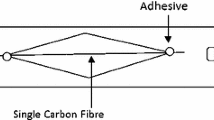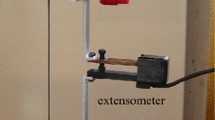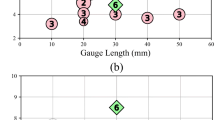Abstract
Statistical strength analysis of advanced fibres is often performed using the Weibull distribution. This statistical approach is firstly made to give a fine but concise summary of the numerous experimental data with two or three significant parameters only and to allow easy discussion of the physical mechanisms, e.g. of the influence of annealing treatments on mechanical properties. Secondly it is a way for deducing properties of a material within a structure or in another testing geometry (other gauge lengths for instance).
Too great an error in the statistical determination of ‘physical’ parameters does not permit achieving any of these purposes. Therefore, some thoughts on the precision of the usual method of statistical determination of the Weibull parameters, as well as a ‘new’ method which is more confident, are proposed.
Similar content being viewed by others
References
El. M. Asloun, J.B. Donnet, G. Guilpain, M. Nardin and J. Schultz, Journal of Materials Science 24 (1989) 3504–3510.
J.J. Masson, K. Schulte, F. Girot and Y. Le Petitcorps, in Proceedings of E-MRS 1990 Spring Meeting, Symp. B. Strasbourg, May 29–June 1, in Materials Science and Engineering A.
Y. Kasai and M. Saito, Fibers Science and Technology 12 (1979) 21–29.
K.K. Phani, Composites Science and Technology 30 (1987) 59–71.
Fu He and R.E. Wang, in Proceedings of International Symposium on Composite Materials Structures, Technonic: Lancaster (1986) 75–79.
J.W. Hitchen and D.C. Phillips, Fibers Science and Technology 12 (1979) 217–233.
Y. Le Petitcorps, Ph. D., University of Bordeaux I, France, Dec. 1985.
H. Goda and H. Fukunaga, Journal of Materials Science 21 (1986) 4475–4480.
S.H. Own, R.v. Subramanian and S.C. Saunders, Journal of Materials Science 21 (1986) 3912–3920.
S.D. Durham, J.D. Lynch and W.J. Padgett, Journal of Composite Materials 22 (1988) 1131–1140.
H.D. Wagner, Journal of Polymers Science 29 (1) (1989) 115–149.
H.D. Wagner, Hybrid Effects in the fatigue behaviour of hybrid composites, Department of Materials Research, Weizman Institute of Science, PCL-88-01, February 88.
E. Bourgain and J.J. Masson, Composite Science and Technology 43 (1992) 221–228.
K. Trustman and A. de S. Jayatilaka, Journal of Materials Science 14 (1979) 1080–1084.
B. Bergman, Journal of Materials Science Letters 3 (1984) 689–692.
A. Khalili, Statistik und Festigkeit. DKG-Seminar, 22–23. Febr. 1989, Stuttgart.
D.R. Thomas, L.J. Bain and C.E. Antle, Technonetics 11, No. 3 (1969) 445–460.
K.J. Chen and R.J. Diefendorf, in Proceedings of the IV International Conference on Composite Materials, Tokyo (1982) 97–105.
S.L. Phoenix and R.G. Sexmith, Journal of Composite Materials 6 (1972) 322–337.
Author information
Authors and Affiliations
Rights and permissions
About this article
Cite this article
Masson, J.J., Bourgain, E. Some guidelines for a consistent use of the Weibull statistics with ceramic fibres. Int J Fract 55, 303–319 (1992). https://doi.org/10.1007/BF00035188
Received:
Accepted:
Issue Date:
DOI: https://doi.org/10.1007/BF00035188




